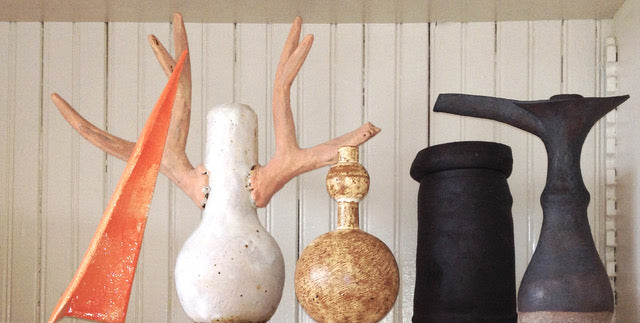With Ben Teague’s artwork, both nothing and everything is what it seems. Teague himself playfully suggests that the prefix PARA- may be the best way to describe his work.
It’s a natural fit for the Cranbrook Academy of Art alumnus who wears a multitude of hats himself: sculptor and ceramicist; University of Michigan arts lecturer; associate curator at the Maxine and Stuart Frankel Foundation for Art; and mandolinist and vocalist with the acoustic trio Behind the Times.
Teague is the featured artist for Pewabic’s one-day solo exhibition Kiln Pad Pop-Up 1-4 PM Sunday, Oct. 22, held rain or shine in the courtyard of the historic pottery.
Available for purchase during the event. Teague’s work encompasses “everything under the sun,” he says, including traditional functional pottery like vessels and towel hooks, as well as nonfunctional pieces that he says riffs off the more functional pieces. His art often makes allusions — and can almost be illusions — likely to catch the knowing eye of ceramic insiders.
Teague readily admits that his work mixes and matches subjects and sets, in part because nothing successfully holds his attention for all that long. It reflects “a changing of channels,” a term he attributes to Tony Hepburn, the late ceramic artist and educator who was Teague’s mentor. Hepburn passed away in 2015.
The pop-up’s temporary setting feeds Teague’s curiosity about the spectrum of time, from the almost instantaneous communication his music supplies in real time to the greater commitment of time ceramics inherently require. Teague sees the exhibition as bringing an amalgamation of concepts, exploration and work into the confines of a single moment.

“That’s the only way I can see that level of intense exploration can be communicated. I feel it’s as intense as I can possibly make the experience and that’s exactly what I want. It’s completely unique,” says Teague. “It’s a huge investment of time that’s condensed.”
The exhibition also combines two concepts that intrigue Teague: play and problem-solving.
“It goes back to the idea of PARA-: Each particular piece is meant to solve a problem or is a possible solution to a problem,” says Teague. “Odawara Hatsunori told me after finishing one form made repeatedly over the course of a month or so, that now I could make anything. I don’t think he meant like anything in the world, but that was my interpretation later, so I went with it, leading me to making darts, mirrors, and tricycles that all functioned from clay.”

